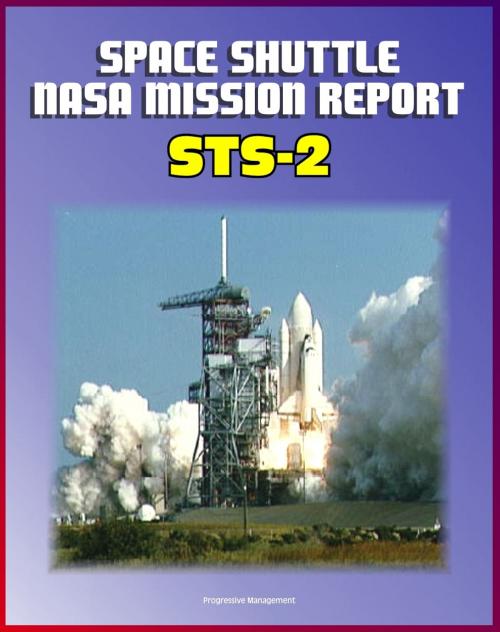Space Shuttle NASA Mission Report: STS-2, November 1981 - Second Flight of Columbia, Complete Technical Details of Orbiter Performance and Problems, Mission Events
Nonfiction, Science & Nature, Science, Physics, Astronomy, History, Americas| Author: | Progressive Management | ISBN: | 9781465878243 |
| Publisher: | Progressive Management | Publication: | December 20, 2011 |
| Imprint: | Smashwords Edition | Language: | English |
| Author: | Progressive Management |
| ISBN: | 9781465878243 |
| Publisher: | Progressive Management |
| Publication: | December 20, 2011 |
| Imprint: | Smashwords Edition |
| Language: | English |
This is the official final orbiter mission report issued by the NASA Johnson Space Center for the flight of STS-2, the second Space Shuttle mission, launched in November 1981 with Joe Engle and Richard Truly. Fifty orbiter anomalies are discussed. Each orbiter system is reviewed in detail, with technical information on performance and anomalies.
Mission objectives included: Demonstrate safe re-launch and safe return of the orbiter and crew. Verify the combined performance of the entire shuttle vehicle - orbiter, solid rocket boosters and external tank.
Payloads included the Orbital Flight Test Pallet consisting of the Measurement of Air Pollution from Satellite (MAPS) experiment, the Shuttle Multispectral Infrared Radiometer (SMIRR) experiment, the Shuttle Imaging Radar (SIR-A) experiment, the Features Identification and Location Experiment (FILE) and the Ocean Color Experiment (OCE). Also included was the 11,048 lb. Development Flight Instrumentation (DFI) pallet, the Aerodynamic Coefficient Identification Package (ACIP), the Induced Environment Contamination Monitor (IECM) and the 5,395 lb. Office of Space and Terrestrial Applications Pallet (OSTA-1).
Mission Highlights - Launch originally set for Oct. 9 was rescheduled when a nitrogen tetroxide spill occurred during loading of the forward reaction control system. The launch scheduled for Nov. 4 delayed and then scrubbed when the countdown computer called for hold in the count due to an apparent low reading on fuel cell oxygen tank pressures. During the hold, high oil pressures were discovered in two of three auxiliary power units (APUs) that operate hydraulic system. APU gear boxes needed to be flushed and filters replaced, forcing the launch to reschedule. The launch on Nov. 12 delayed two hours, 40 minutes to replace the multiplexer/demultiplexer and additional nine minutes, 59 seconds to review systems status.
Modifications of the water sound suppression system at the pad to absorb the solid rocket booster overpressure wave during launch were effective -- no tiles were lost and only 12 were damaged.
The planned five-day mission was cut nearly three days due to failure of one of three fuel cells that produce electricity and drinking water, but 90 percent of mission objectives achieved, including first time remote manipulator system tests. Mission scientists were satisfied with data received from Office of Space and Terrestrial Applications-1 (OSTA-1) Earth observation experiments mounted on Spacelab pallet in payload bay.
This is the official final orbiter mission report issued by the NASA Johnson Space Center for the flight of STS-2, the second Space Shuttle mission, launched in November 1981 with Joe Engle and Richard Truly. Fifty orbiter anomalies are discussed. Each orbiter system is reviewed in detail, with technical information on performance and anomalies.
Mission objectives included: Demonstrate safe re-launch and safe return of the orbiter and crew. Verify the combined performance of the entire shuttle vehicle - orbiter, solid rocket boosters and external tank.
Payloads included the Orbital Flight Test Pallet consisting of the Measurement of Air Pollution from Satellite (MAPS) experiment, the Shuttle Multispectral Infrared Radiometer (SMIRR) experiment, the Shuttle Imaging Radar (SIR-A) experiment, the Features Identification and Location Experiment (FILE) and the Ocean Color Experiment (OCE). Also included was the 11,048 lb. Development Flight Instrumentation (DFI) pallet, the Aerodynamic Coefficient Identification Package (ACIP), the Induced Environment Contamination Monitor (IECM) and the 5,395 lb. Office of Space and Terrestrial Applications Pallet (OSTA-1).
Mission Highlights - Launch originally set for Oct. 9 was rescheduled when a nitrogen tetroxide spill occurred during loading of the forward reaction control system. The launch scheduled for Nov. 4 delayed and then scrubbed when the countdown computer called for hold in the count due to an apparent low reading on fuel cell oxygen tank pressures. During the hold, high oil pressures were discovered in two of three auxiliary power units (APUs) that operate hydraulic system. APU gear boxes needed to be flushed and filters replaced, forcing the launch to reschedule. The launch on Nov. 12 delayed two hours, 40 minutes to replace the multiplexer/demultiplexer and additional nine minutes, 59 seconds to review systems status.
Modifications of the water sound suppression system at the pad to absorb the solid rocket booster overpressure wave during launch were effective -- no tiles were lost and only 12 were damaged.
The planned five-day mission was cut nearly three days due to failure of one of three fuel cells that produce electricity and drinking water, but 90 percent of mission objectives achieved, including first time remote manipulator system tests. Mission scientists were satisfied with data received from Office of Space and Terrestrial Applications-1 (OSTA-1) Earth observation experiments mounted on Spacelab pallet in payload bay.















